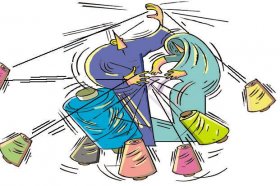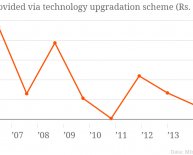
Production of textile industry in India
 India’s textile industry has a long history of being a mainstay of the economy’s global trade linkages. It was, after all, the English East India Company’s focus on trade of cotton and silk from India that made it one of the richest and most powerful corporations in the 18th century. Today, India has the second largest manufacturing capacity in textiles globally and accounts for 13% of the world’s production of textile, fibre and yarn. However, it lags in terms of competitiveness and productivity.
India’s textile industry has a long history of being a mainstay of the economy’s global trade linkages. It was, after all, the English East India Company’s focus on trade of cotton and silk from India that made it one of the richest and most powerful corporations in the 18th century. Today, India has the second largest manufacturing capacity in textiles globally and accounts for 13% of the world’s production of textile, fibre and yarn. However, it lags in terms of competitiveness and productivity.
In this context, the special package of Rs.6, 000 crore announced last week for boosting the textile industry is important for many reasons. After fully reaping the benefits of access to the markets of developed economies in the post-Uruguay Round world, China is beginning to exit the textiles and apparel sector due to rising domestic wages. This leaves a huge demand base for India to exploit as rightly recognized by the government.
When the Multi Fibre Agreement imposed by developed countries on the developing world was phased out, it was expected that India would benefit from it too. But the textile industry hasn’t been able to scale up accordingly. Besides, rigidities in the labour market, import restrictions on competing man-made fibres, export quotas on cotton and logistics costs prevented the country from reaping the benefits. This second opportunity now must not be wasted.
The Agreement of Textiles and Clothing under the World Trade Organisation vouches for equal treatment to be meted out to all nations. But Vietnam and Bangladesh are already securing better terms for themselves via free trade agreements with major markets. That underlines the urgency of the reforms the sector needs in India.
In the meantime, it has already been looking at countering the problem of negative protectionism which hampers the smooth provisioning of imported inputs required for the industry. Rs.5, 500 crore out of the Rs.6, 000 crore package is for an additional 5% duty drawback for refunding state levies. It is expected that this step will boost exports, increase investment and make the textile industry an integral part of the Make in India programme.
The textile industry is the second largest employer in the country after agriculture; any allocation to it has a multiplier effect on the economy at large. According to an Assocham report, employment generated in the economy because of a rise of Rs.1 in demand of the industry, is more than 5 times the employment created in the sector itself.
The government’s decision to incentivize textile and apparel firms to absorb more labour by offering to pay a portion of the Employees’ Provident Fund for new employees will further enhance this effect. Female labour force participation rate is also expected to increase from a boost to the textile industry.
But if the textile and apparel industry has to become competitive at an international level, it needs a major revamp. The issues of productivity suffered by an industry largely restricted to the small scale and unorganized sectors needs to be addressed. Incidentally, around 60% of the spindles used in India are more than 25 years old.
Meanwhile, emphasis should be laid on promotion and marketing of textiles and designs that are indigenous to India. Fabindia’s success in branding and marketing Indian designs and textiles in the global apparel market, for instance, is worth studying here.
Geographical indications could prove to be an effective means of securing a niche market for Indian handloom in foreign markets. India’s muga silk used for Japanese kimonos is a case in point.
Given rising Internet penetration in the country, e-commerce could also be used to the advantage of the textile industry—to eliminate layers of middlemen and improve access. The example of the Taobao model in China where an entire village specializes in the production of a commodity and sells it at competitive prices online is relevant.
But promoting traditional industries does not mean creating a protective shield against the emerging competition from synthetic fibre through tariffs. If an industry has to successfully progress and provide network effects, it must be allowed to grow to its full potential. And for that, it is important to diversify and embrace new innovations.

















